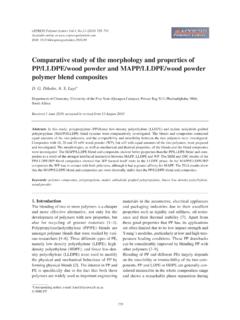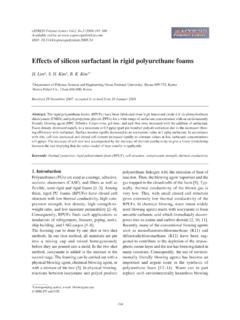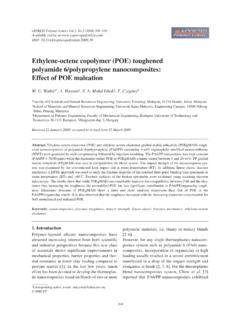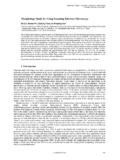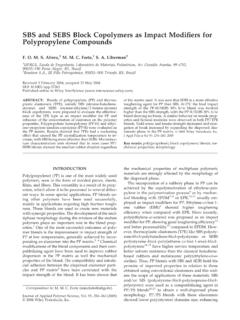Transcription of PP-EPDM thermoplastic vulcanisates (TPVs) by …
1 1. IntroductionThermoplastic elastomers (TPEs) are one of thefastest growing polymeric materials which com-bine the elastic and mechanical properties of cross-linked rubbers with the melt processability ofthermoplastics [1, 2]. TPEs find lot of applicationsin automotives, buildings and constructions, wiresand cables, soft touch etc. The most importantadvantage of a TPE is its ability to reuse and recy-cle the production scrap and waste. tpvs ordynamic vulcanisates are a special class of TPEs,produced by simultaneously mixing and cross-link-ing a rubber with a thermoplastic at elevated tem-perature [3 5]. As a result a typical morphology isformed, where the cross-linked rubber particles arefinely dispersed in a continuous matrix of thermo-plastic.
2 tpvs based on blends of PP and epdm rubber are most significant from a commercialpoint of view, where the rubber phase is generallycross-linked either by activated phenol formalde-hyde resins or by peroxides [6 12]. Besides advan-tages, both resin and peroxide cross-linkingsystems have their own limitations. For instance,phenolic resin has a strong tendency to absorbmoisture even at ambient temperature and alsoappear as a dark brown color. On the other hand,peroxide cross-linked tpvs often provide anunpleasant smell or may show a blooming , the rate of generation of peroxide rad-icals at a constant temperature changes as a func-tion of time.
3 These disadvantages of resins andperoxides create a demand for other *Corresponding author, e-mail: BME-PTPP- epdm thermoplastic vulcanisates ( tpvs ) by electroninduced reactive processingK. Naskar1,2, U. Gohs1*, U. Wagenknecht1, G. Heinrich11 Leibniz-Institut f r Polymerforschung Dresden , Hohe Strasse 6, D-01069 Dresden, Germany2 Rubber Technology Centre, Indian Institute of Technology, Kharagpur, Kharagpur-721302, West Bengal, IndiaReceived 23 June 2009; accepted in revised form 12 August processing combines melt mixing process and chemical reaction simultaneously. tpvs are produced bysuch reactive processing. Polymer modification with high energy electrons is based on generation of excited atoms or mol-ecules and ions for subsequent molecular changes via radical induced chemical reactions.
4 In the present study, electroninduced reactive processing is used for the development of tpvs . A MeV electron accelerator was directly coupled toan internal mixer in order to induce chemical reactions by energy input via high energy electrons under dynamic conditionsof melt mixing of polypropylene (PP) and ethylene propylene diene monomer rubber ( epdm ). The influence of absorbeddose (25 to 100 kGy) as well as electron energy ( and MeV) and electron treatment time (15 to 60 s) have been stud-ied. Increased values of both tensile strength and elongation at break of the tpvs indicate in-situcompatibilisation of PPand epdm as well as cross-linking in the epdm phase upon electron induced reactive processing.
5 Dynamic mechanicalanalyses showed a decrease in value of glass transition temperature peak of epdm in tangent delta curve with increasingdose. This also indicates higher degree of cross-linking in epdm phase, which is further supported by a gel content that ishigher than the epdm content itself in the :polymer blends and alloys, PP, epdm , thermoplastic vulcanisate, electron induced reactive processingeXPRESS Polymer Letters , (2009) 677 683 Available online at : vulcanisation by electron induced reac-tive processing is a potential of electron beam (EB) on PP under staticconditions is well known in the literature [13 16]and characterises a process where requiredabsorbed dose is applied to form parts (after mold-ing) in solid state and at room temperature.
6 EBcross-linking of epdm rubber under static condi-tions is also reported by several authors [17 19].The absorbed dose controls the energy input perunit of mass as well as the total number of , the effects of high energy electrons inPP- epdm blends under dynamic conditions werenot yet explored. Electron induced reactive pro-cessing is a novel technique where chemical reac-tions are induced by spatial and temporal preciseenergy input via high energy electrons underdynamic conditions of melt mixing. In this novelprocess, the penetration depth of electrons is lim-ited to a part of mixing volume. The total mixingvolume is modified due to the change of polymermass within the penetration depth of electrons dur-ing mixing process.
7 Further, electron treatmenttime and electron energy do not only control doserate and penetration depth, respectively. In thenovel process, electron treatment time also influ-ences the ratio of radical generation rate to mixingrate (dose per rotation) and electron energy controlsthe ratio of modified volume to total mixing cham-ber volume (rvol).Thus, the primary objective of the present investi-gation is to develop PP-EPDM based tpvs at50:50 blend ratio under various conditions(absorbed dose, electron treatment time and elec-tron energy) of electron induced reactive process-ing. The mechanical, thermal, dynamic mechanical,and morphological characteristics of variousdynamically electron cross-linked PP-EPDM blends were pursued to get an in-sight.
8 2. MaterialsBuna EP G 6850, the ethylidene norbornene (ENB)containing epdm rubber, was obtained fromLanxess, Leverkusen, Germany. The epdm con-tains 51 wt% of ethylene and wt% of ENB. Ithas a Mooney viscosity, ML (1+4) at 125 C of 60and a density of g/cm3. PP HD120MO, apolypropylene homopolymer, was obtained fromBorealis, D sseldorf, Germany. The melt flow rateof the polypropylene, measured at 230 C kg, amounts to g/10 min. It has a densityof Preparation of PP/ epdm TPVsAll tpvs were prepared by a batch process in aBrabender mixing chamber, having a mixing cham-ber volume of 50 cm3, with a rotor speed of 45 rpmat 175 180 C in presence of air.
9 The friction ratioof the rotors amounts to 1 Figure 1 shows aschematic representation of the unique set-up. Thetotal time of mixing was 16 min due to safety regu-lations of electron accelerator. The experimentalvariables were absorbed dose (25, 50, and100 kGy), electron treatment time (15, 30, and60 s), and electron energy ( and MeV).Immediately after mixing, the composition waspressed manually by metallic plates without anyadditional heating to achieve a sheet of about 2 mmthickness. This sheet was cut into small pieces andpressed in a compression molding machine (RucksMaschinenbau, Glauchau, Germany) at 200 C,6 min, and 88 bar pressure.
10 The sheet was thencooled down to room temperature under specimens were die-cut from the compressionmolded sheet and used for testing after 24 h of stor-age at room et al. eXPRESS Polymer Letters , (2009) 677 683 Figure representation of the set-up: couplingof an electron accelerator with an internal Testing procedureTensile tests were carried out according to ISO527-2/S2/50 on dumb-bell shaped specimens usingan universal tensile testing machine Zwick a constant cross-head speed of 50 mm/min. Emodulus was determined in between of strain. Differential scanning calorimeter(DSC) measurements were carried out using a DSCQ1000 (TA instruments, New Castle, USA).
